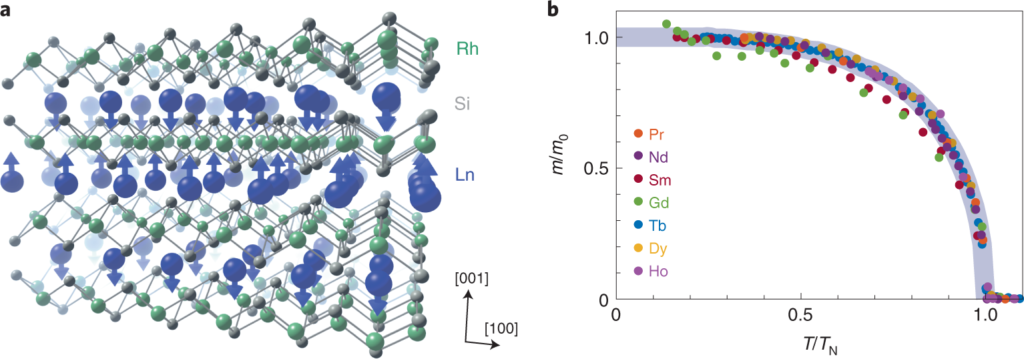Fine-tuning the speed of magnetic devices
Some metals, alloys and transition-element salts exhibit a form of magnetism called antiferromagnetism. This occurs below a certain temperature, named after Louis Néel, when an ordered array of atomic magnetic moments spontaneously forms in which alternate moments have opposite directions. There is therefore no net resultant magnetic moment in the absence of an applied field. Néel also showed that, in the presence of strong spin–orbit coupling on the ion and an interionic exchange interaction between the spins, these should be proportional, as observed, to what later became known as the de Gennes factor.
Antiferromagnets, materials with multiple spin sublattices, can allow direct angular momentum transfer between opposing spins, something quite useful for ultrafast manipulation of magnetism and with great potential for future information technologies.
Lanthanides are increasingly important in this respect because their 4f spin moments reach exceptionally large sizes compared to those of 3d transition metals. For applications involving ultrafast spin dynamics, however, the localized nature of 4f magnetism poses an additional challenge compared to its 3d counterpart. Highly confined to the space near their ion, the magnetic 4f electronic states generally are not conduction electrons as in the 3d case, but lie several electronvolts below the Fermi level. Therefore, 4f electrons are typically not directly optically excited. Instead, optical pulses excite the conduction electrons, which mediate the RKKY coupling between the 4f spins.
As the participation of dispersive electronic states renders RKKY exceptionally sensitive to external factors, a systematic investigation into the role of 4f occupation on ultrafast magnetization dynamics is needed. This is easier said than done, though, because a systematic study of elemental lanthanide metals is hindered by the large variety of different crystal structures and magnetic phases they exhibit, further complicating a meaningful comparison.

Now, a team of researchers facilitates 1 a direct comparison of 4f dynamics under comparable conditions by studying ultrafast magnetization dynamics in a series of lanthanide intermetallic antiferromagnets with nearly identical crystal and magnetic structures all across the lanthanide series. This way the influence of 4f occupation can be singled out.
The antiferromagnets studied using time-resolved soft X-ray diffraction have the form LnRh2Si2 (where Ln is a lanthanide element). These share the same crystal structure and 4f spin arrangement, such that the only appreciable difference between them is the occupation of the Ln ions’ 4f shell.
The researchers find that, while demagnetization timescales differ by nearly two orders of magnitude between materials, the corresponding angular momentum transfer rates clearly exhibit a linear relation to the de Gennes factor mentioned above, a so-called de Gennes scaling. The ab initio calculations performed identify this as transfer between antiparallel moments and show that it scales with the magnitude of the RKKY coupling between them.
This approach provides a microscopic picture of such antiferromagnetic angular momentum transfer, yielding insight substantially beyond phenomenological models, which often do not consider this transfer channel. Given the high sensitivity of RKKY to the conduction electrons, these results offer a useful way for fine-tuning the speed of magnetic devices.
Author: César Tomé López is a science writer and the editor of Mapping Ignorance
Disclaimer: Parts of this article may have been copied verbatim or almost verbatim from the referenced research paper/s.
References
- Y.W. Windsor, S.-E. Lee, D. Zahn, D., V. Borisov, D. Thonig, K. Kliemt, A. Ernst, C. Schüßler-Langeheine, N. Pontius, U. Staub, C. Krellner, D. V. Vyalikh, O. Eriksson & L. Rettig (2022) Exchange scaling of ultrafast angular momentum transfer in 4f antiferromagnets. Nat. Mater. (2022) doi: 10.1038/s41563-022-01206-4 ↩